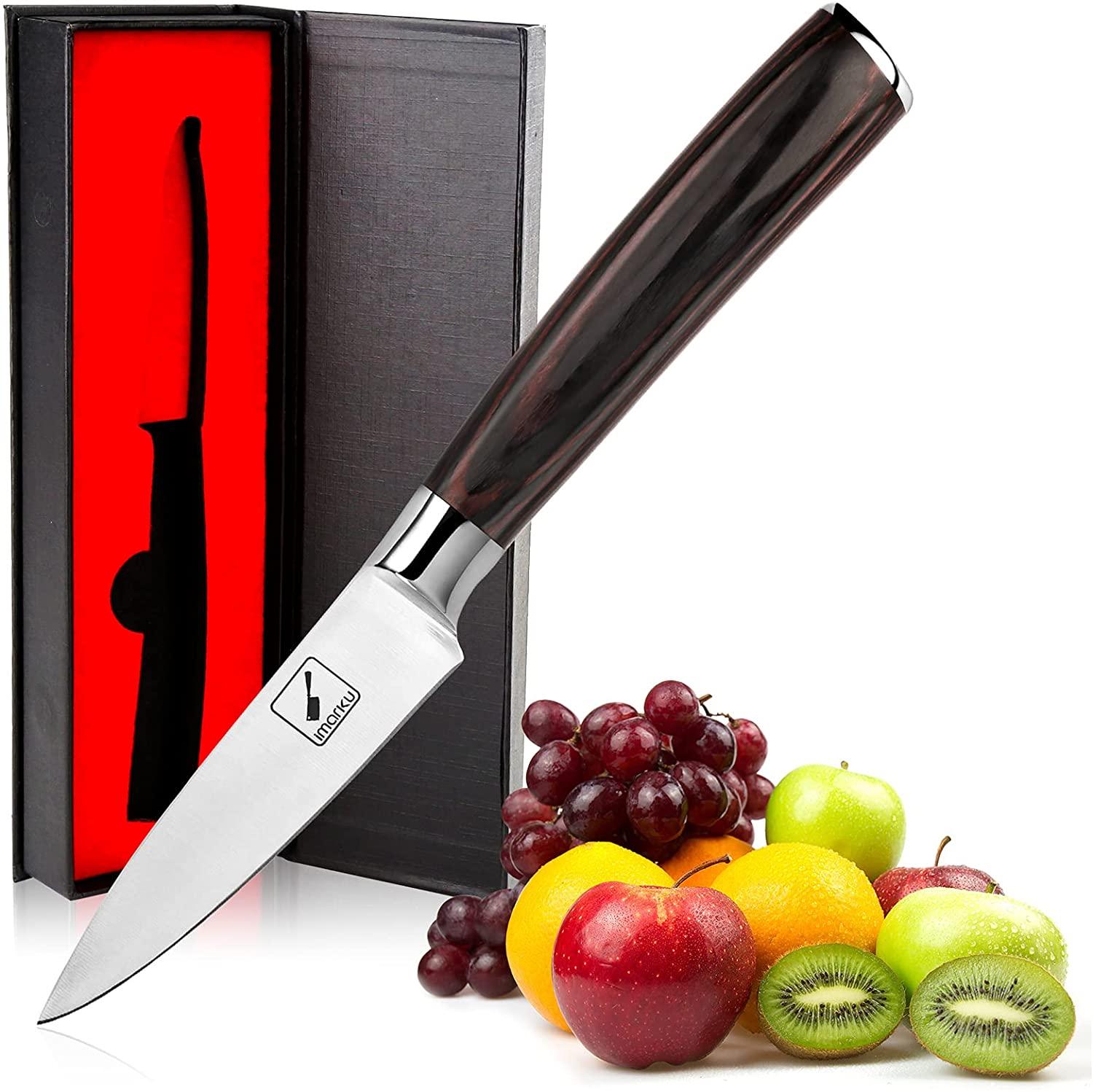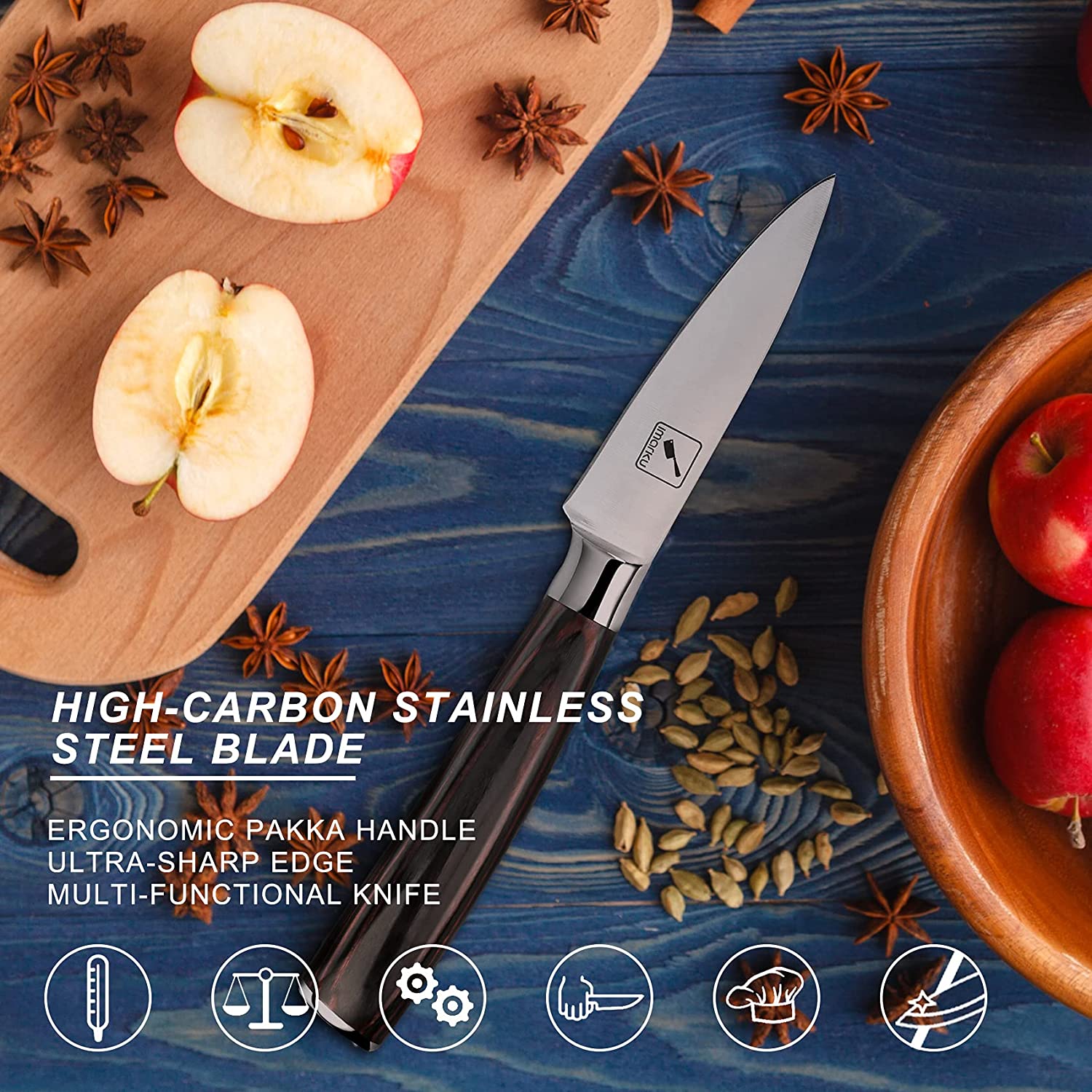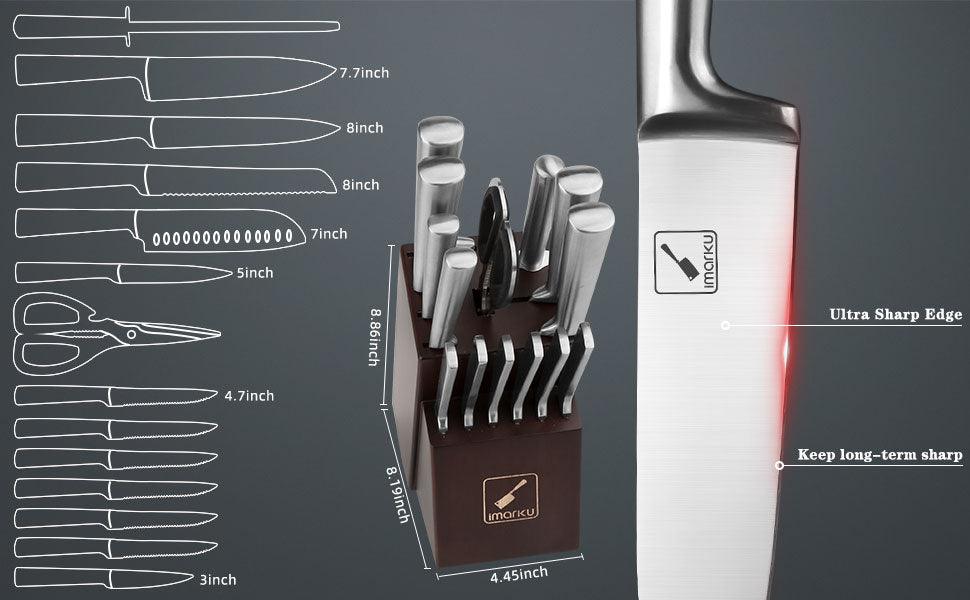TABLE OF CONTENTS
What your kitchen needs the most are knives. The role of knives is often overlooked, but once you get down to it, it's hard to think of any kitchen task that won't need knives. Whether you are deboning your next meal, slicing fruit for a juice, or peeling your next snack, you will need a knife at your hands.
While most people only have a general use knife, the truth is that there are unique knives for every different task you can think of. Today, we'll focus on explaining the paring knife. This small blade might look underwhelming at first glance, but its sheer precision and versatility come to light when you understand its use.

What is a paring knife?
Paring knives are synonymous with a short blade. Unlike most knives which tend to be 7 inches or longer, paring knives have a small blade ranging from 2.5 inches to 4 inches. Combined with their regular-sized handle, paring knives can often look mismatched, but the size of the blade does have a logic behind it.
When it comes to paring knives, precision is the main priority. Since paring knives are short, and the blade's tip is always close to your hand, they are easy to man-oeuvre and operate. This ultimately means that your cuts will be more accurate, and you will be able to handle delicate tasks way more easily than with a large chef's knife.
Paring knives are ideal for precise tasks like peeling and deveining, but they can also be used for general tasks like chopping or cutting. However, it is important to keep in mind the limitations of a small knife.
Regardless of the sharpness, paring knives will struggle against meat, bread, or particularly sturdy vegetables like pumpkin. Paring knives are most often associated with vegetables; since they can easily chop most of them and are also the best possible pick to peel them.

Why is it called a paring knife?
Since "paring" is not a common term outside of kitchen fans, the name of these knives might leave you a little stumped. However, the term itself is 100% tied to the function of paring knives, and once you learn the logic behind the term, it'll all make sense.
According to the dictionary, to "pare" something means to cut away from its outer layer or to reduce its amount. In other words, pare and peel are functionally synonymous in the kitchen, and this is precisely what paring knives are best known to do.
However, the word itself doesn't originate from kitchens. Instead, the term "pare" comes from french bookmakers. Back in the 16th-century, bookmakers would use a "couteau à parer" to thin the edges of a book, specifically it's leather bindings. This spatula-like tool became synonymous with trimming, and before too long, pare became a term that got used for trimming and peeling in the kitchen.

What does a paring knife do?
Now that we know how to differentiate paring knives from their peers and understand why they are called that way, we should understand the basics. What are paring knives used for? What makes them so good at their job? And how should we approach these small blades when we are working in the kitchen.
Peeling, of course, is the most popular function of paring knives. You can chop vegetables with a chef's knife, but trying to peel them with a large blade is not safe or practical at all. So if you choose to get a paring knife of your own, it'll mostly be used for peeling. The thing with peeling food is that the skin of each fruit or vegetable behaves differently, but for the most part, you should be able to handle anything that comes your way.
There are two main ways to start peeling depending on the vegetable and your personal preferences. The most common method involves making an indent with the tip of the knife on the skin. Afterwards, take the edge of the blade and start peeling from that first indent. This technique is particularly useful for fruits or vegetables that have slippery skins like tomatoes, as the initial indent provides the perfect starting point to peel.
Alternatively, you can take off the top part of the fruit or vegetable with a firm slice of your knife. This will expose the insides and the skin, and you can slice downwards to remove the skin at your pace. It's easier to try this with an orange, but it can be useful with anything that has thick skin.
Paring knives are also essential for deveining and deseeding. When it comes to deseeding, all you need is precision; once your vegetable is open, you can use the knife as a scoop to get rid of all the seeds. Deveining, on the other hand, does require a proper technique. If you are deveining a shrimp, you'll need to make a shallow cut along the back of it. As long as the vein is already exposed, you can use the knife to lift and pull the vein slowly, it might take some tries at first, but it'll become second nature in no time at all.
Last but not least, paring knives are great for chopping vegetables, especially if you are trying to get thin slices. Whether it's garlic, peppers or Brussels, the small paring knives make them ideal for precise cuts. And since you use them to peel, they'll always be at hand when you need to start chopping.
Paring knives vs Utility knives
Utility knives are the closest counterpart to paring knives in the market, making it hard to understand their differences and which knife to pick for each task.
First and foremost, let's understand what a utility knife is. Utility knives are generally speaking the second shortest knives you can find in a kitchen. A utility knife blade ranges from 4 to 7 inches, so its size starts right where paring knives left off.
The above ultimately means that utility knives are a middle point between paring and chef knives, and their uses match that. Utility knives aren't quite as sharp and sturdy as most chef knives, but they aren't as precise as traditional paring knives. This means that compared to paring knives, they won't be good for peeling or deveining. Their blades are too large, and this means that your precision will be lower. So even if their sharpness would allow you to peel vegetables, it's just not safe for you.
On the other hand, since they are larger and bulkier, they can easily match paring knives when chopping. They are arguably better for chopping since they can take on meat, unlike paring knives.
However, their functions don't overlap much. Utility knives are meant to be multi-purpose knives that can be used for most odd jobs in the kitchen. While paring knives are all about precision and peeling. They can be used to chop anything they peel, but their priority is still peeling.
Good paring knife option
If you are looking for a good paring knife for your kitchen, you don't need to look any further than the iMarku 3.5" Paring Peeling Fruit Knife. iMarku is famous for providing international quality at great prices, and this knife is no exception.
The build quality is the first thing that stands out. A pakkawood handle provides a perfect grip that maximizes comfort and provides a premium finish. The blade itself is German stainless steel, but it also contains 0.6-0.75g of carbon to add more value. This makes the blade more durable. In fact, it's twice as durable as its peers since most blades only contain roughly 0.3% carbon.
So when it comes to the materials, the value is there, but iMarku also made sure to offer a great design on top of that. The 3.5" blade has that classic spear shape making it easy to puncture any skin and peel. The edge is slightly curved to make it easier to rock the blade as you peel, and since the knife is hand sharpened, you can rest assured this knife will go through any vegetable like butter.
iMarku offers an amazing design and builds quality in a very affordable package, and that makes this knife a deal nobody should miss on. If you are interested in paring knives, this is one of the best options in the market, and we assure you that once you get accustomed to using the right knife for each task, your kitchen experience will change for the best.
However, their functions don't overlap much. Utility knives are meant to be multi-purpose knives that can be used for most odd jobs in the kitchen. While paring knives are all about precision and peeling. They can be used to chop anything they peel, but their priority is still peeling.

























Leave a comment
All comments are moderated before being published.
This site is protected by hCaptcha and the hCaptcha Privacy Policy and Terms of Service apply.